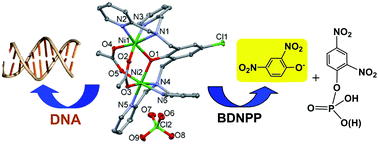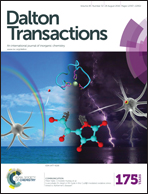Dinuclear metal(ii)-acetato complexes based on bicompartmental 4-chlorophenolate: syntheses, structures, magnetic properties, DNA interactions and phosphodiester hydrolysis†
Abstract
A series of dinuclear metal(II)-acetato complexes: [Ni2(μ-LClO)(μ2-OAc)2](PF6)·3H2O (1), [Ni2(μ-LClO)(μ2-OAc)2](ClO4)·CH3COCH3 (2), [Cu2(μ-LClO)(μ2-OAc)(ClO4)](ClO4) (3), [Cu2(μ-LClO)(OAc)2](PF6)·H2O (4), [Zn2(μ-LClO)(μ2-OAc)2](PF6) (5) and [Mn2(LCl-O)(μ2-OAc)2](ClO4)·H2O (6), where LClO− = 2,6-bis[bis(2-pyridylmethyl)aminomethyl]-4-chlorophenolate, were synthesized. The complexes were structurally characterized by spectroscopic techniques and single crystal X-ray crystallography. Six-coordinate geometries with doubly bridged acetato ligands were found in Ni(II), Zn(II) and Mn(II) complexes 1, 2, 5 and 6, whereas with Cu(II) complexes a five-coordinate species was obtained with 4, and mixed five- and six-coordinate geometries with a doubly bridged dimetal core were observed in 3. The magnetic properties of complexes 1–4 and 6 were studied at variable temperatures and revealed weak to very weak antiferromagnetic interactions in 1, 2, 4 and 6 (J = −0.55 to −9.4 cm−1) and ferromagnetic coupling in 3 (J = 15.4 cm−1). These results are consistent with DFT calculations performed at the B3LYP/def2-TZVP(-f) level of theory. Under physiological conditions, the interaction of the dinculear complexes 1–5 with supercoiled plasmid ds-DNA did not show any pronounced nuclease activity, but Ni(II) complexes 1 and 2 revealed a strong ability to unwind the supercoiled conformation of ds-DNA. The mechanistic studies performed on the interaction of the Ni(II) complexes with DNA demonstrated the important impact of the nickel(II) ion in the unwinding process. In combination with the DNA study, the phosphatase activity of complexes 1, 3, and 5 was examined by the phosphodiester hydrolysis of bis(2,4-dinitrophenol)phosphate (BDNPP) in the pH range of 5.5–10.5 at 25 °C. The Michaelis–Menten kinetics performed at pH 7 and 10.7 showed that catalytic efficiencies kcat/KM (kcat = catalytic rate constant, KM = substrate binding constant) decrease in the order: Ni(II), 1 > Zn(II), 5 > Cu(II), 3. A similar trend was also observed with the turnover numbers at pH = 7. The results are discussed in relation to the coordination geometry and nature of the metal center as well as the steric environment imposed by the compartmental phenoxido ligand.



 Please wait while we load your content...
Please wait while we load your content...